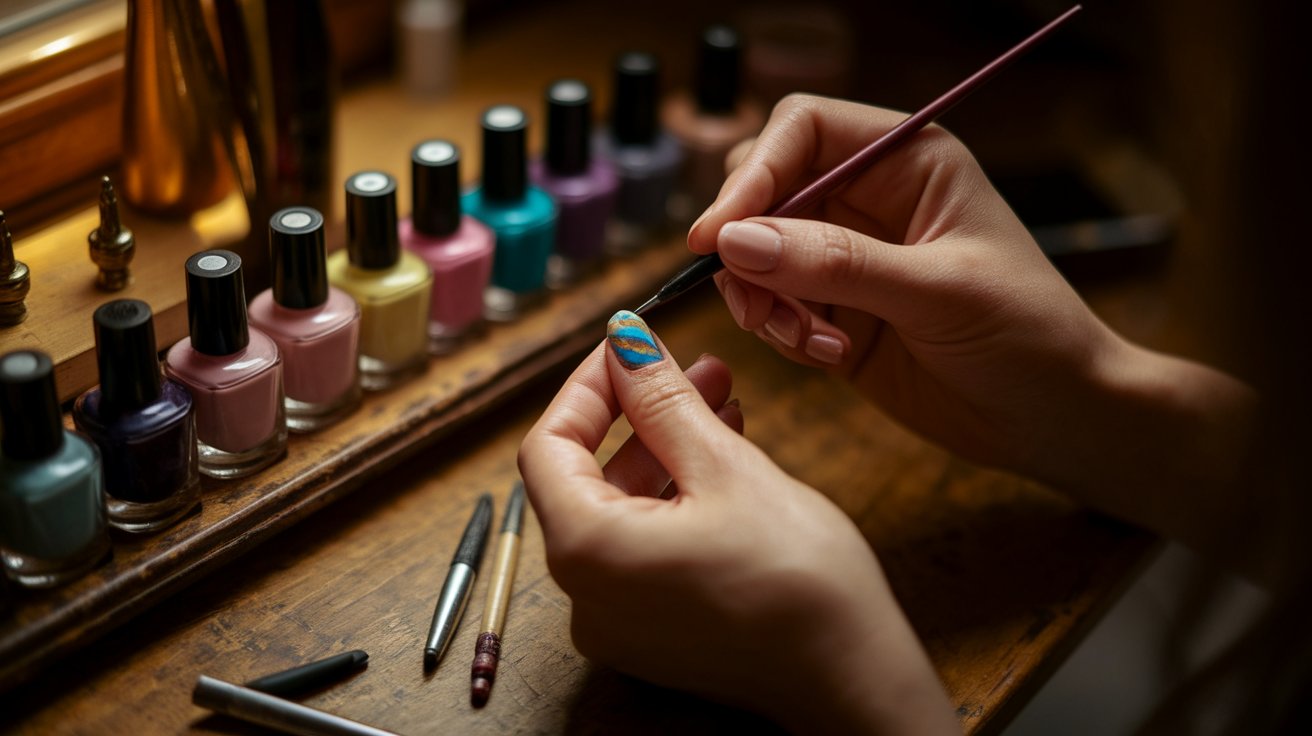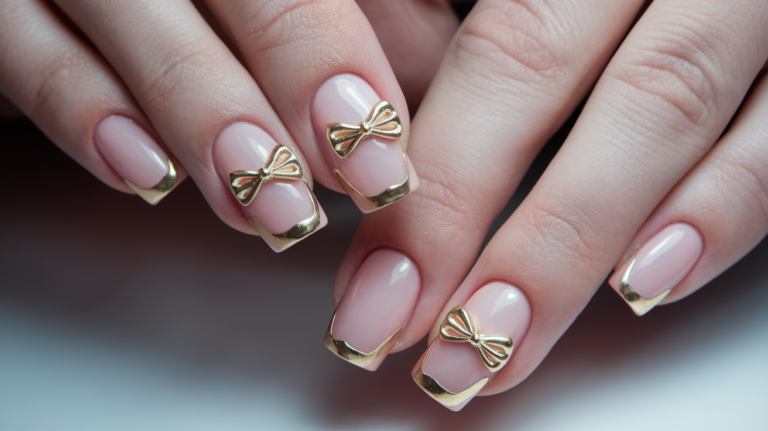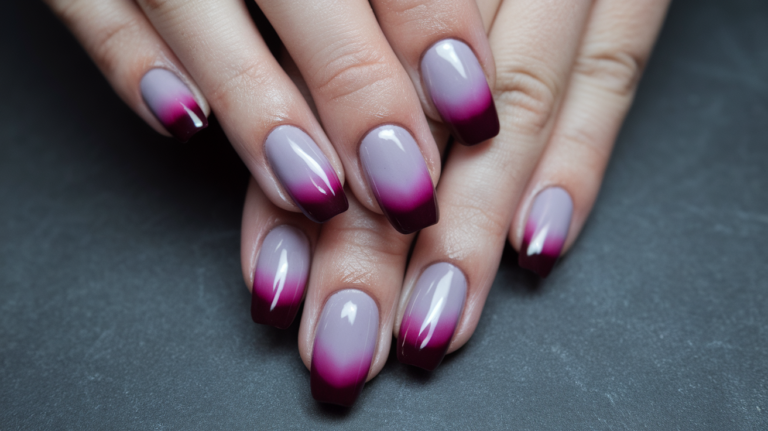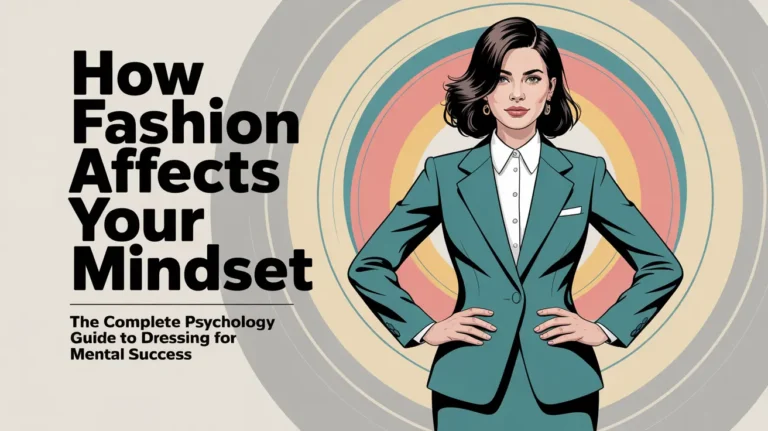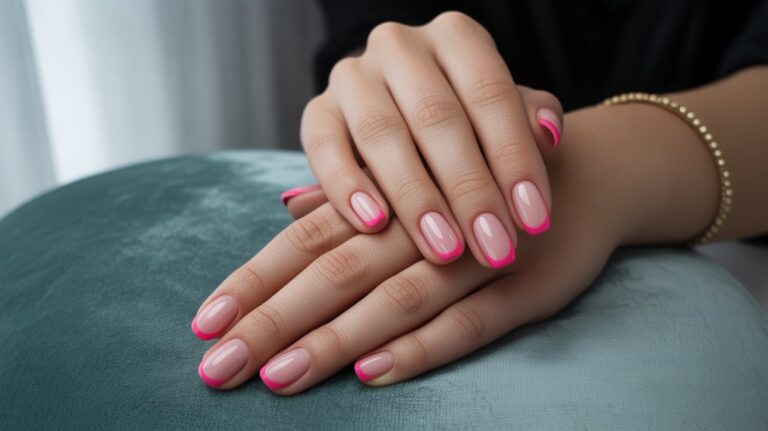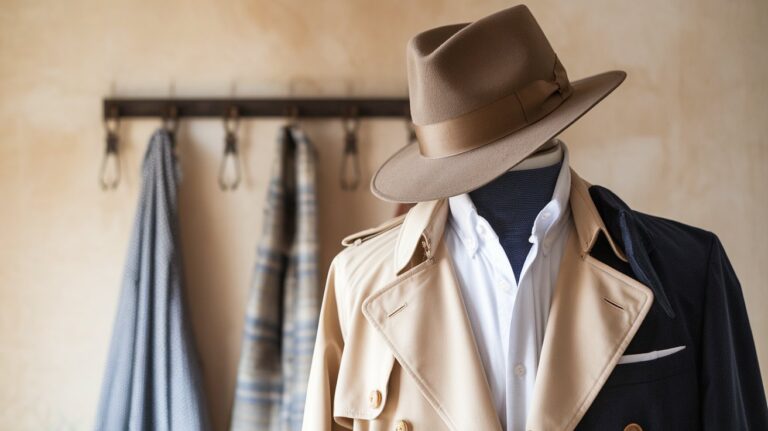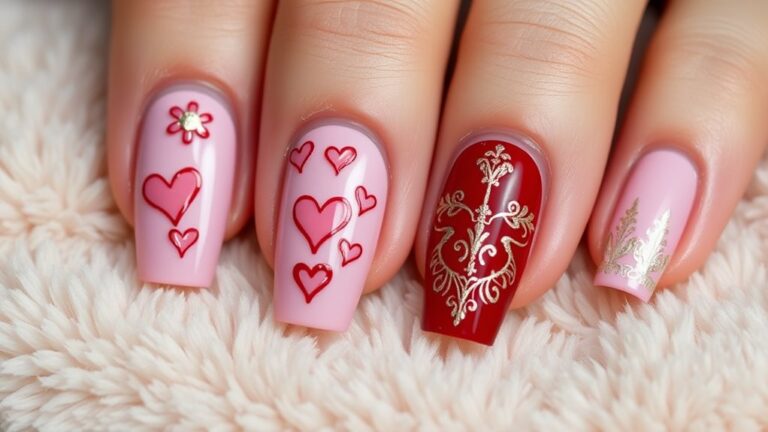The Complete Evolution of Nail Art: From Ancient 3000 BC to Modern 3D Masterpieces
Nail art has transformed from simple color applications to intricate masterpieces that rival fine art. What began as basic French tips in nail salons has evolved into a multi-billion dollar industry featuring complex 3D sculptures, LED-embedded designs, and AI-generated patterns.
This comprehensive journey through nail art history reveals not just aesthetic changes, but cultural shifts, technological breakthroughs, and the democratization of self-expression through fingertip canvases.
Master the Evolution: Nail Art Timeline
The Ancient Roots: When Nails First Became Art (3000 BC – 1900 AD)
Ancient Civilizations and Social Status
Long before Instagram nail tutorials, ancient civilizations understood the power of decorated nails. In 3000 BC China, nail polish wasn’t just about beauty—it was a strict social hierarchy indicator. The wealthy adorned their nails with gold and silver lacquers made from:
- Gelatin for base consistency
- Vegetable dyes for vibrant colors
- Egg whites for glossy finish
- Beeswax for durability
According to Ancient Pages, historians and archaeologists confirm that fingernail painting originated in ancient China around 3000 BC, with the Chinese experimenting with different ingredients to create the world’s first nail polish formulations.
During the Ming Dynasty, elaborate nail guards protected fashionably long nails, some extending up to 10 inches. These ornate protectors, crafted from precious metals and adorned with gemstones, demonstrated wealth and leisure—long nails meant you didn’t perform manual labor.
Research from The China Temper confirms that during the Ming dynasty (1368-1644), long nails and nail guards became prominent wealth symbols, with wearers needing assistance for daily tasks due to their impractical length.
Egyptian Opulence and Henna Artistry
Ancient Egypt elevated nail decoration to royal art. Queen Cleopatra famously wore deep red hues symbolizing power, while Queen Nefertiti preferred ruby shades. Egyptian nail artists used:
- Henna for natural reddish-brown tones
- Rich oils for nail health and shine
- Natural pigments derived from plants and minerals
The bolder the color, the higher the social rank—a tradition that established nail art’s connection to status and self-expression. Archaeological evidence from NAILS Magazine documents that Queen Nefertiti painted her nails ruby red while Cleopatra favored rust colors, with commoners restricted to pale hues under penalty of death.
The Birth of Modern Nail Polish (1900-1920)
Scientific Breakthrough: From Chemistry Lab to Beauty Counter
The nail art revolution began in 1911 when Chicago chemist Northam Warren developed Cutex, the first commercial cuticle remover. This scientific approach to nail care laid the foundation for modern nail artistry:
Timeline of Early Innovations:
- 1911: First cuticle remover (Cutex)
- 1916: First liquid nail polish
- 1917: First rose-tint nail polish
- 1920s: High-gloss car paint adapted for nails
Women in the roaring twenties literally used automobile paint on their nails, seeking that glossy, durable finish that matched their era’s industrial optimism.
The Classic Era: Establishing Timeless Trends (1920-1950)
The 1920s-1930s: Hollywood Glamour and Half-Moon Magic
This era established many techniques still popular today. The half-moon manicure became the signature look of sophisticated women:
Half-Moon Technique Process:
- Clean and shape nails
- Apply base coat
- Use fine brush to outline crescent at nail base
- Paint entire nail except outlined crescent
- Seal with top coat
Revlon’s 1932 breakthrough introduced the first commercial red nail polish with actual pigments instead of dyes, creating longer-lasting, more vibrant colors. Their iconic shades “Cherries in the Snow” and “Fire and Ice” became cultural phenomena.
The 1940s-1950s: Wartime Practicality Meets Post-War Glamour
World War II brought practical concerns to beauty routines. Women saved metal for the war effort, leading to shorter nails and more subdued colors. However, the post-war boom exploded with innovation.
1955: The Accidental Revolution
Dentist Frederick Slack‘s broken nail led to the invention of acrylic nail extensions. Using dental acrylic and aluminum foil, he created the first nail form—accidentally launching the artificial nail industry that now generates billions annually. The innovation fundamentally changed cosmetic chemistry and beauty applications, establishing the foundation for modern nail enhancement techniques.
The French Manicure: Timeless Elegance Defined
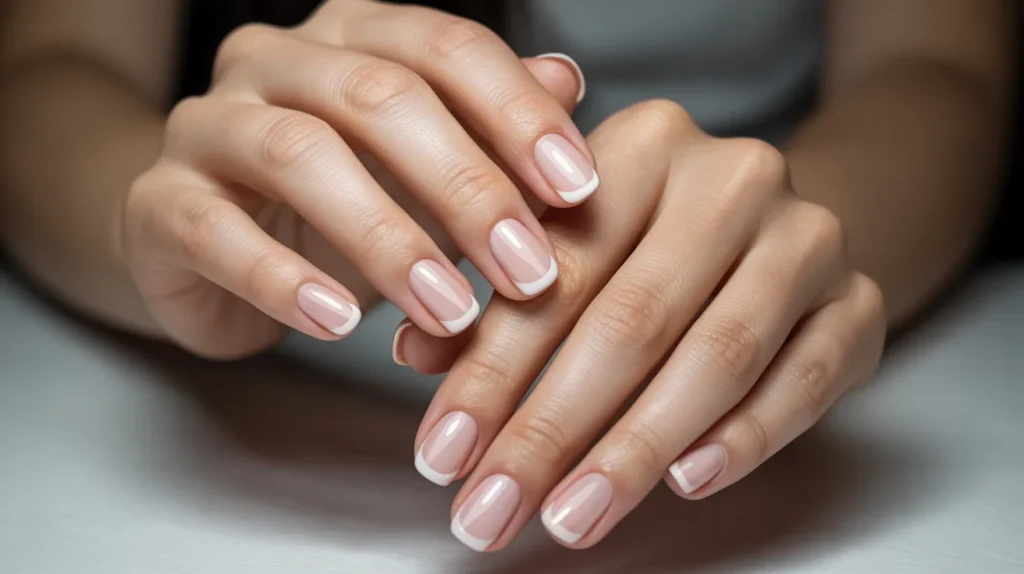
Origins and Evolution of the Iconic Look
Contrary to popular belief, the French manicure wasn’t invented in France. Jeff Pink, founder of Orly International, created this look in 1975 for Hollywood actresses who needed versatile nails for quick costume changes.
This innovation solved a major problem in film production, where actresses previously needed time-consuming nail changes between scenes, making the French manicure both practical and elegant.
Classic French Manicure Components:
- Nude or pink base representing natural nail bed
- White tips mimicking natural nail growth
- Clean, geometric lines suggesting health and precision
- Glossy finish adding sophistication
Cultural Explosions: Decades of Self-Expression (1960-2000)
The Psychedelic 1960s-1970s: Freedom and Color
The counterculture movement transformed nail art into personal rebellion. Key characteristics included:
- Earth tones reflecting environmental consciousness
- Bright oranges and yellows channeling sunshine optimism
- Disco glitter for nightlife glamour
- Long artificial nails as status symbols
Nail charms and 3D elements first appeared during this era, with disco balls, peace signs, and flower power motifs adorning fingertips.
The Electric 1980s: Neon and Excess
The 1980s embraced “more is more” philosophy:
Popular 1980s Elements:
- Neon colors: Electric pink, lime green, bright purple
- Metallic foils for futuristic effects
- Nail stickers for easy pattern application
- Glitter stones creating texture and sparkle
- Striping tape for geometric designs
This decade democratized nail art through affordable nail art kits, making complex designs accessible to home users.
The Grunge 1990s: Rebellion Through Imperfection
The 1990s rejected 1980s excess with deliberately imperfect aesthetics:
- Dark colors: Black, plum, deep burgundy
- Chipped polish as intentional style choice
- Matte finishes rejecting traditional glossiness
- Minimalist designs focusing on color over decoration
Sharpie markers became unofficial nail art tools, with teens touching up black polish chips for that perfectly imperfect grunge look.
The Y2K Explosion: Maximum Bling Era (2000-2010)

3D Everything: When Nails Became Sculptures
The new millennium brought maximum embellishment:
Y2K Nail Art Characteristics:
- 3D charms: Bows, hearts, miniature objects
- Chunky crystals in multiple sizes
- Mixed textures combining smooth and rough elements
- Bright color combinations rejecting subtle coordination
- Length competitions with increasingly dramatic extensions
Technology Meets Artistry
UV gel technology revolutionized durability and design possibilities:
- Longer wear time (2-3 weeks vs. 3-5 days)
- Enhanced strength supporting elaborate 3D work
- Better adhesion for heavy embellishments
- Curing precision allowing intricate layering
The Social Media Revolution: Instagram Nails and Viral Trends (2010-2020)
The Rise of Nail Influencers
Instagram transformed nail art from salon service to global phenomenon. Key developments:
Platform Impact Statistics:
- #nailart: Over 100 million posts
- #nailinspo: 50+ million posts
- #nailsofinstagram: 30+ million posts
- Professional nail artists gaining millions of followers
The massive engagement demonstrates nail art’s cultural impact, with content generating significantly higher interaction rates than traditional beauty categories, establishing it as one of the most influential niches in social media marketing.
Gel Polish Dominance
Gel manicures became the new standard, offering:
- 2-3 week durability vs. traditional 3-5 days
- Chip-resistant finish maintaining perfect appearance
- Instant drying under UV/LED lights
- Extensive color range with new releases monthly
Dip Powder Innovation
Dip powder systems emerged as a hybrid solution:
Dip Powder Benefits:
- No UV light required (safer for frequent users)
- 4+ week wear (longest-lasting option)
- Strengthening formula improving natural nail health
- Easy removal without extensive filing
Contemporary 3D Designs: Nail Art as Fine Art (2020-Present)
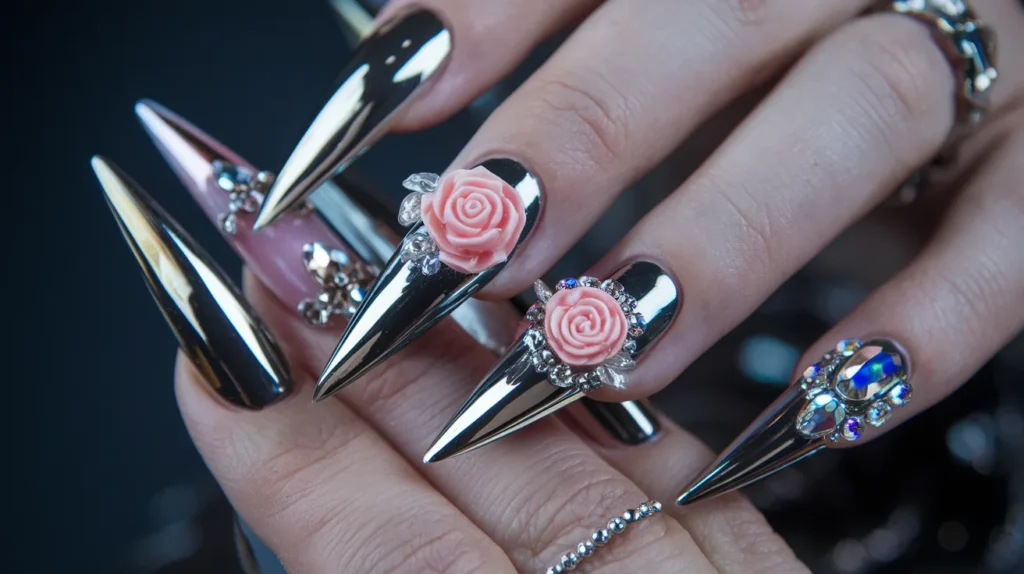
Advanced 3D Techniques
Modern 3D nail art pushes creative boundaries:
Popular 3D Elements:
- Sculptured flowers with realistic petals and shading
- Miniature landscapes featuring mountains, trees, and skies
- Portrait work recreating faces and characters
- Abstract sculptures exploring form and texture
- Mixed media incorporating fabric, metal, and unconventional materials
Tools Revolutionizing 3D Creation
Professional artists now use specialized equipment that would be unrecognizable to early nail technicians. According to Sixth Tone’s cultural analysis, the evolution from simple metal nail guards to today’s sophisticated 3D tools represents one of beauty history’s most dramatic technological leaps.
Essential 3D Tools:
- Acrylic sculpting brushes in various sizes
- Dotting tools for precision placement
- Silicone molds for consistent shapes
- 3D gel mediums maintaining form while curing
- Fine-detail brushes for intricate painting
The Chrome and Glass Effect Revolution
Chrome powders and glass effect techniques create mirror-like finishes:
Chrome Application Process:
- Apply black gel base
- Cure under UV/LED light
- Apply no-wipe top coat
- Rub chrome powder with silicone tool
- Seal with appropriate top coat
Glass effect variations:
- Shattered glass: Iridescent films creating broken glass illusion
- Cellophane nails: Clear overlays with holographic properties
- Glazed donut: Pearl-like finish popularized by Hailey Bieber
Cultural and Social Impact of Nail Art Evolution
Economic Influence
The nail industry has become a major economic force:
Industry Statistics (2024):
- Global market value: $15.7 billion
- Annual growth rate: 8.1%
- Professional nail salons: 400,000+ worldwide
- Home nail product sales: $2.8 billion annually
The nail industry’s remarkable growth trajectory shows continued expansion projections through 2030, driven by social media influence, technological innovations, and increasing consumer investment in self-care and personal expression.
Self-Expression and Identity
Modern nail art serves multiple psychological functions:
Personal Benefits:
- Creative outlet for artistic expression
- Confidence booster through personal style
- Cultural connection maintaining traditions
- Professional networking in beauty communities
- Stress relief through meditative application process
Breaking Gender Norms
Male nail art has gained mainstream acceptance:
- Celebrity influence: A$AP Rocky, Machine Gun Kelly, Harry Styles
- Professional acceptance in creative industries
- Social media normalization through male nail artists
- Product development gender-neutral marketing
The shift reflects broader social progress in gender expression, with male participation in traditionally female beauty practices becoming increasingly normalized and celebrated across demographics.
Future Trends: Where Nail Art is Heading
Technology Integration
Smart nails represent the next frontier:
Emerging Technologies:
- LED-embedded designs with programmable patterns
- Temperature-sensitive polishes changing color with body heat
- Magnetic levitation elements creating floating effects
- Augmented reality integration for virtual try-ons
- Bio-responsive materials reacting to health indicators
Sustainable Innovation
Eco-friendly nail art addresses environmental concerns:
Sustainable Developments:
- Biodegradable glitters replacing plastic alternatives
- Plant-based formulas reducing chemical dependency
- Refillable packaging minimizing waste
- Non-toxic ingredients prioritizing health safety
- Local sourcing reducing transportation impact
Research from Racked’s beauty industry analysis demonstrates how sustainable nail products can significantly reduce the beauty industry’s environmental footprint when widely adopted.
AI and Customization
Artificial intelligence is personalizing nail art:
AI Applications:
- Pattern generation based on personal preferences
- Color matching with wardrobe and skin tone
- Design prediction analyzing trend data
- Technique tutorials providing personalized instruction
- Virtual consultations with professional artists
Professional Evolution
The nail artist profession continues expanding:
Career Opportunities:
- Specialized 3D artists commanding premium prices
- Social media educators teaching techniques online
- Product developers creating new materials and tools
- Competition judges evaluating artistic merit
- Franchise owners building nail art empires
DIY vs. Professional: Choosing Your Nail Art Journey
Home Nail Art Advantages
DIY benefits:
- Cost savings over salon visits
- Convenience of home timing
- Skill development through practice
- Creative freedom without time constraints
- Personal satisfaction from self-creation
Professional Services Benefits
Salon advantages:
- Technical expertise for complex designs
- Professional tools unavailable to consumers
- Time efficiency for busy schedules
- Hygiene standards with sterilized equipment
- Trend awareness from industry professionals
Hybrid Approach
Many enthusiasts combine both:
Balanced Strategy:
- Professional base for difficult techniques
- Home maintenance between salon visits
- DIY experimentation with new trends
- Salon consultation for special occasions
- Skill building through gradual complexity increase
The Endless Evolution of Nail Art
The journey from simple French tips to today’s elaborate 3D sculptures represents more than aesthetic evolution—it reflects humanity’s endless creativity and desire for self-expression. What began as ancient status symbols has transformed into a democratic art form accessible to anyone with imagination and basic tools.
Key takeaways from nail art’s evolution:
- Cultural reflection: Each era’s nail trends mirror its social movements and values
- Technology advancement: Scientific breakthroughs continuously expand creative possibilities
- Democratization: Social media and accessible tools have made professional-quality art achievable at home
- Economic impact: The nail industry has grown into a multi-billion dollar global market
- Future potential: Emerging technologies promise even more revolutionary changes ahead
As we look toward the future, one thing remains certain: nail art will continue evolving, surprising us with innovations we can’t yet imagine. While you prefer classic French elegance or cutting-edge 3D sculptures, you’re participating in an ancient art form that connects you to thousands of years of human creativity.
The next chapter in nail art evolution is being written right now, on fingertips around the world. What will your nails contribute to this ongoing story?
Ready to start your own nail art journey? When you’re drawn to timeless French elegance or cutting-edge 3D innovations, remember that every masterpiece starts with a single brushstroke. The evolution continues with each creative choice you make, adding your unique voice to this centuries-old art form that shows no signs of slowing down.
Essential Resources for Your Nail Art Journey
| Skill Level | Essential Tools | Investment |
|---|---|---|
| Beginner | Base coat, 3 colors, top coat, dotting tools | $25-50 |
| Intermediate | Above + nail art brushes, striping tape, rhinestones | $75-125 |
| Advanced | Above + 3D gels, chrome powders, sculpting tools | $150-300 |
Educational platforms like Coursera and Udemy now offer comprehensive nail art certification courses, reflecting the professionalization of this creative field.

